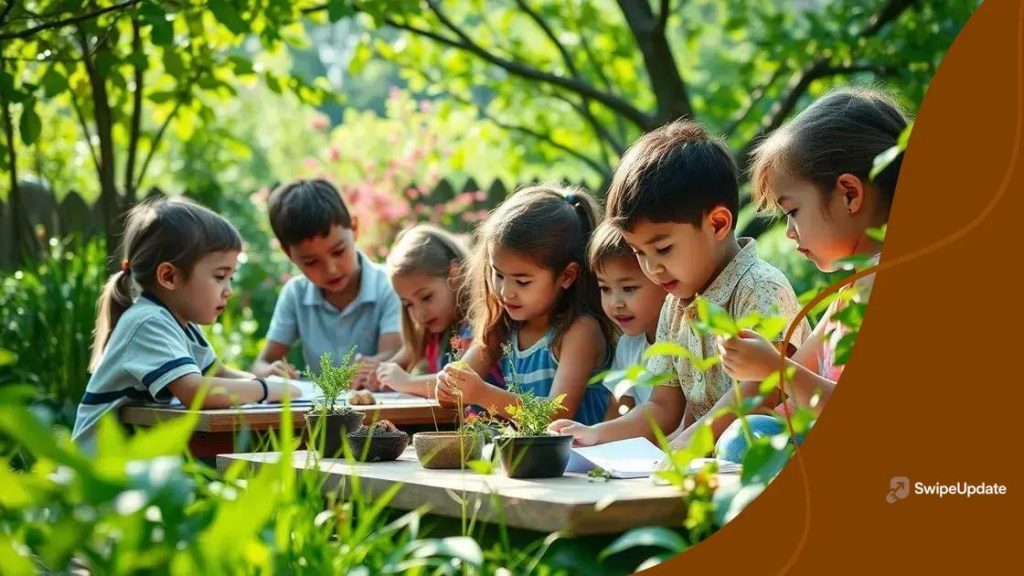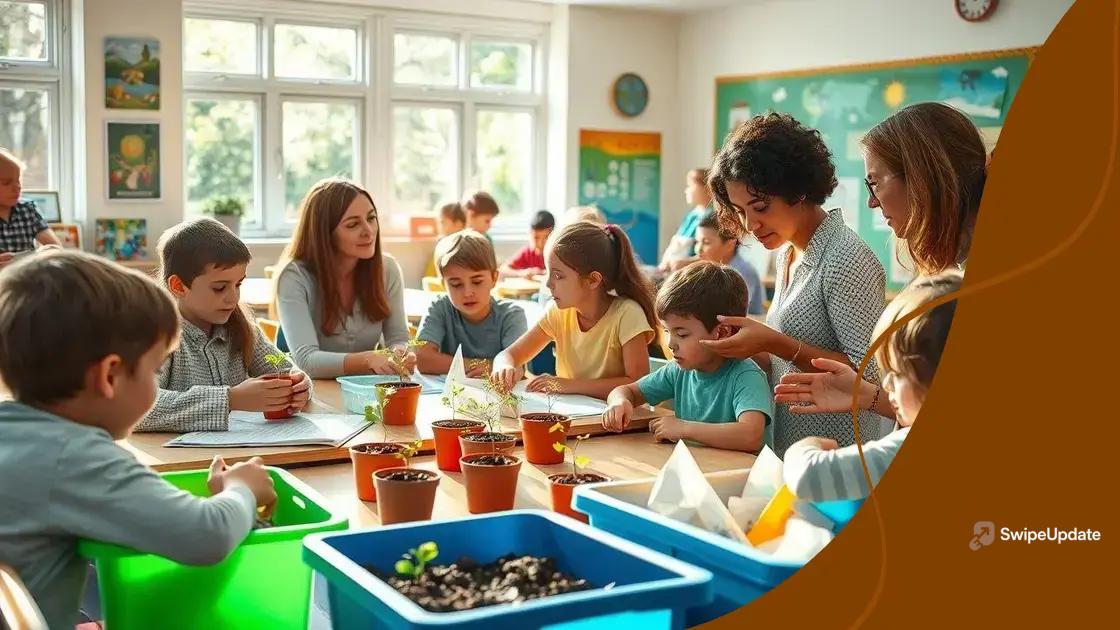Eco-literacy in schools: why it matters now more than ever

Eco-literacy in schools equips students with essential knowledge and skills to understand environmental issues and make informed decisions, fostering responsible behavior towards sustainability and community engagement.
Eco-literacy in schools is becoming essential as we face environmental challenges. Have you ever wondered how educating kids about sustainability can change their perspectives? In this article, we’ll explore how fostering eco-literacy can create a more informed and responsible generation.
Understanding eco-literacy and its importance
Understanding eco-literacy is essential in today’s world. As environmental issues like climate change grow, becoming eco-literate helps us navigate these challenges. It’s more than just knowing about the environment; it involves understanding how our choices impact the planet.
What is eco-literacy?
Eco-literacy refers to the knowledge and skills needed to understand ecological principles and make informed decisions. It empowers individuals to think critically about their relationship with nature. By embracing eco-literacy, students can become advocates for sustainability.
Why is it important?
The importance of eco-literacy cannot be overstated. It fosters a sense of responsibility towards the environment. Some key reasons include:
- Encouraging sustainable practices among future leaders
- Boosting critical thinking skills related to environmental issues
- Promoting community involvement in ecological initiatives
Incorporating eco-literacy into school curricula helps students relate their studies to real-world scenarios. They start to see connections between their education and the environment around them. For instance, learning about local ecosystems can inspire students to participate in conservation efforts.
Moreover, eco-literacy enhances students’ awareness of global challenges. They learn about biodiversity loss, pollution, and climate change, which are issues that require immediate attention. Schools that embrace eco-literacy create environments where students are encouraged to experiment, innovate, and find solutions to these pressing problems.
As educators, it’s crucial to introduce eco-literacy at an early age. This foundation will ensure that children grow into informed adults ready to tackle environmental challenges. Whether through hands-on projects, outdoor classrooms, or integrated lessons, the goal remains the same: foster a generation that values and protects our planet.
Practical strategies for teaching eco-literacy
Teaching eco-literacy effectively requires practical strategies that engage students and promote active learning. By implementing hands-on experiences, educators can foster an appreciation for the environment while educating about sustainability.
Hands-on learning experiences
One of the best ways to teach eco-literacy is through hands-on learning. Students can participate in activities like gardening, recycling projects, and habitat restoration. These activities help them connect theory to practice, making lessons more memorable and impactful.
Utilizing the local environment
Schools should take advantage of their local environment. Organizing field trips to nearby parks or nature reserves allows students to observe ecosystems firsthand. They learn how local plants and animals interact, emphasizing the importance of biodiversity. Such experiences create lasting impressions and foster curiosity.
Integrative lesson plans
Creating integrative lesson plans that combine eco-literacy with subjects like science, art, and social studies can provide a more cohesive understanding. For example, a science lesson on the water cycle can include discussions about pollution’s effect on water quality. Students can create visual art projects that reflect their understanding of local ecosystems. Such integration encourages creativity while deepening their knowledge.
Community involvement
Involving the community is another vital strategy. Schools can partner with local environmental organizations for workshops and campaigns. This not only broadens students’ perspectives but also instills a sense of responsibility towards their surroundings. Students may participate in community clean-up days or conservation efforts, seeing the direct impact of their actions.
Moreover, incorporating technology can enhance teaching methods. Utilizing apps and online resources allows students to explore environmental data and trends. Interactive tools can make learning about climate change more accessible and engaging.
Ultimately, the goal of teaching eco-literacy is to empower students to make informed choices. By providing them with varied practical strategies, we can nurture environmentally conscious citizens who advocate for a sustainable future.
Integrating eco-literacy into existing curricula

Integrating eco-literacy into existing curricula is crucial for fostering a generation of environmentally conscious students. By weaving eco-literacy into different subjects, educators can create a more holistic learning experience.
Cross-curricular connections
One effective approach is to establish cross-curricular connections. For example, in a science class, students can learn about ecosystems while also discussing the impact of pollution. In social studies, the effects of climate change on various communities can be explored. This integrative method allows students to see the relevance of their studies in real-world contexts.
Project-based learning
Project-based learning is another powerful strategy for integrating eco-literacy. Teachers can design projects that encourage students to investigate local environmental issues. For instance, students could work on a project to assess their school’s carbon footprint or create a garden to learn about native plants. These hands-on experiences deepen understanding and encourage active participation.
Moreover, using technology can enhance the integration of eco-literacy. There are many resources available, such as interactive apps and websites that provide insight into environmental data and trends. Incorporating these tools into lessons allows students to engage with the material dynamically. They can analyze graphs, read articles, and even watch videos that relate to eco-literacy themes.
Teachers should also encourage discussions around environmental ethics. Engaging students in conversations about sustainability not only enriches their knowledge but also strengthens their critical thinking skills. Discussions can revolve around topics like recycling, renewable energy, and sustainable agriculture.
Furthermore, training teachers in eco-literacy ensures that they feel confident in delivering these lessons. Professional development workshops can provide teachers with tools and resources to incorporate eco-literacy effectively. Once teachers are equipped, they can inspire their students to become advocates for the environment.
Benefits of eco-literacy for students and communities
The benefits of eco-literacy reach far beyond the classroom, impacting both students and their communities. By fostering an understanding of environmental issues, learners become equipped to tackle challenges and drive change.
Empowerment of students
One significant benefit is empowerment. As students learn about ecological principles, they gain confidence. They realize that their actions can have a positive impact on the environment. This sense of agency motivates them to participate in local initiatives.
Enhanced critical thinking skills
Furthermore, eco-literacy enhances critical thinking skills. Students learn to analyze information related to environmental issues. They engage in discussions and debates about sustainability, which helps them form their own opinions. This ability to think critically prepares them for future challenges in various fields.
- Students can assess news stories about climate change objectively.
- They learn to identify credible sources of information.
- They develop problem-solving skills through project-based learning.
Additionally, eco-literacy fosters collaboration among students. Working together on projects allows them to share diverse perspectives and learn from one another. This collaboration enhances communication skills and builds teamwork abilities.
For communities, the presence of eco-literate students can lead to impactful changes. As these students take action, they inspire others to do the same. Community events, like clean-up drives or tree planting, often gain traction when initiated by local youth. This collective effort strengthens community ties, promoting a culture of sustainability.
Long-term environmental benefits
Moreover, eco-literacy creates long-term environmental benefits. As more individuals become informed about sustainability, communities begin to see positive shifts in behavior. Increased awareness leads to better recycling practices and reduced waste. Over time, these actions contribute to healthier ecosystems.
Ultimately, the ripple effect of eco-literacy can change societies. Educated individuals promote sustainable practices in their homes and workplaces. As these principles are adopted more widely, communities become more resilient to environmental challenges, paving the way for a brighter, sustainable future.
Success stories: schools excelling in eco-literacy
Success stories of schools excelling in eco-literacy provide inspiring examples of how education can create positively motivated students. These examples highlight innovative practices and effective strategies that other schools can replicate.
Case Study 1: Green Elementary School
At Green Elementary School, an eco-literacy program focuses on hands-on learning. Students engage in gardening, composting, and studying local wildlife. This not only teaches them about ecosystems but also encourages responsibility towards the environment. Their school garden serves as a living classroom where students learn about nutrition and sustainability.
Case Study 2: Riverside High School
Riverside High School has successfully integrated eco-literacy across the curriculum. Science classes study climate change, while social studies explore the socio-economic effects of environmental policies. The school’s Earth Club initiates community clean-up events, uniting students with local residents. Such community involvement reinforces the lessons learned in class.
Case Study 3: Harmony Academy
Harmony Academy’s unique approach involves cross-disciplinary learning. They’ve partnered with local environmental organizations to create projects that tackle real-world challenges. For example, students conducted a waste audit for their school, analyzing waste production and proposing effective reduction strategies. This hands-on project not only educated students but also led to actionable change within the school.
These schools showcase the breadth of opportunities available when eco-literacy is prioritized. Whether it’s hands-on projects, community engagement, or integrating eco-consciousness into various subjects, the impact is profound. Students emerge more informed and inspired to act.
Through these success stories, we see the positive changes that occur when eco-literacy programs are in place. Students become advocates for environmental justice and sustainability, leading the way for future generations. Their enthusiasm can influence families and communities, creating a ripple effect toward sustainable practices.
FAQ – Frequently Asked Questions about Eco-Literacy in Schools
What is eco-literacy?
Eco-literacy is the understanding of ecological principles and how human actions impact the environment. It empowers students to make informed decisions for a sustainable future.
How can eco-literacy benefit students?
Eco-literacy helps students develop critical thinking skills, encourages environmental responsibility, and motivates them to engage in community initiatives.
What are some successful examples of eco-literacy in schools?
Schools like Green Elementary and Riverside High School incorporate hands-on projects, community involvement, and cross-curricular lessons to excel in eco-literacy.
Why is community involvement important in eco-literacy programs?
Community involvement enhances students’ learning experiences and helps bridge the gap between classroom knowledge and real-world applications, fostering a culture of sustainability.
